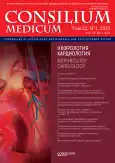Levels of high-sensitivity C-reactive protein in young and middle-aged working men
- Authors: Kirichenko A.A.1, Polyakova O.A.1, Dubovskaia I.N.2
-
Affiliations:
- Russian Medical Academy of Continuous Professional Education
- Diagnostic and Rehabilitation Center of Gazprom Transgaz Moscow
- Issue: Vol 23, No 1 (2021)
- Pages: 99-102
- Section: Articles
- URL: https://journals.rcsi.science/2075-1753/article/view/95461
- DOI: https://doi.org/10.26442/20751753.2021.1.200577
- ID: 95461
Cite item
Full Text
Abstract
Full Text
##article.viewOnOriginalSite##About the authors
Andrey A. Kirichenko
Russian Medical Academy of Continuous Professional Education
Email: andreyapollonovich@yandex.ru
д-р мед. наук, проф. Moscow, Russia
Olga A. Polyakova
Russian Medical Academy of Continuous Professional Educationаспирант Moscow, Russia
Irina N. Dubovskaia
Diagnostic and Rehabilitation Center of Gazprom Transgaz Moscowзав. профпатологическим отд-нием, зав. поликлиническим отд-нием Moscow, Russia
References
- Catapano AL, Graham I, De Backer G, et al. 2016 ESC/EAS GUIDELINES FOR THE MANAGEMENT OF DYSLIPIDAEMIAS. Russian Journal of Cardiology 2017; 5: 7-77.
- Федеральная служба государственной статистики. Демографический ежегодник России -2019. Смертность. Режим доступа: https://gks.ru/bgd/regl/B19_16/Main.htm
- Глущенко В.А., Ирклиенко Е.К. Сердечно-сосудистая заболеваемость - одна из важнейших проблем здравоохранения. Медицина и организация здравоохранения. 2019; 1
- Mawhorter S, Lauer M. Is atherosclerosis an infectious disease? Clev Clinic J Med 2001; 68 (5): 449-58.
- Ridker PM, Hennekens CH, Buring JE, Rifai N. C-reactive protein and other markers of inflammation in the prediction of cardiovascular disease in women. N Engl J Med 2000; 342: 836-43.
- The Emerging Risk Factors Collaboration. C-reactive protein concentration and risk of coronary heart disease, stroke, and mortality: an individual participant meta-analysis. Lancet 2010; 375: 132-40.
- Aday AW, Ridker PM. Targeting Residual Inflammatory Risk: A Shifting Paradigm for Atherosclerotic Disease. Front Cardiovasc Med 2019; 6: 16.
- Кардиоваскулярная профилактика 2017. Российские национальные рекомендации. Рос. кардиол. журн. 2018; 6: 7-122. doi: 10.15829/1560-4071-2018-6-7-122
- Магрук М.А., Мосикян А.А., Бабенко А.Ю. Биомаркеры, ассоциированные с атерогенезом: актуальный статус и перспективные направления. Рос. кардиол. журн. 2019; 24 (12): 148-52
- Погосова Н.В., Юферева Ю.М., Качанова Н.П., и др. Разработка алгоритма диагностики доклинического атеросклероза у пациентов из группы высокого риска развития сердечно-сосудистых заболеваний. Кардиология. 2020; 60 (2): 75-82. doi: 10.18087/cardio.2020.2.n964
- Arnett DK, Blumenthal RS, Albert MA, et al. 2019 ACC/AHA guideline on the primary prevention of cardiovascular disease: a report of the American College of Cardiology/American Heart Association Task Force on Clinical Practice Guidelines. Circulation 2019; 140: e596-e646.
- Российская ассоциация эндокринологов. Проект Клинических рекомендаций по ожирению 2019. Режим доступа: https://raeorg.ru/system/files/documents/pdf/kr_ozhirenie.pdf
Supplementary files






